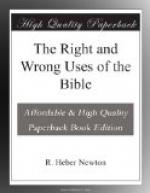[22] Ewald: History of Israel, i. 4.
[23] The Old Testament is a record of the growth of human intelligence in relation to the Deity—of the revelation made by Spirit to spirit. When therefore God is described as speaking to man, he does so in the only way in which He who is a Spirit can speak to one encompassed with flesh and blood; not to the outward organs of sensation, but to that intelligence which is kindred to Himself the great Fountain of knowledge.—Davidson: Introduction to the Old Testament, i. 233.
[24] Emerson: Miscellanies, p. 200.
[25] “To hear people speak,” said Goethe, “one would almost believe that they were of opinion that God had withdrawn into silence since those old times, and that man was now placed quite upon his own feet, and had to see how he could get on without God and his daily invisible breath.”—Conversations, March 11, 1832.
[26] Our advancing knowledge of the early portions of the Bible is clearing its offensive portions of the grossness which characterized them as literal histories, by resolving them into nature-myths, or into social traditions, symbolical stories of casuistry, “token-tales,” whose original meaning had been lost by the time they were committed to writing.
Every school-boy knows how the worst stories of the Greek gods and goddesses lose their immorality as seen to be parables of nature’s processes, myths, whose poetry had exhaled in the course of time. Goldziher’s “Mythology Among the Hebrews,” shows the mythic character of many of these revolting Jewish stories, though his theory carries him off his feet. Fenton’s “Early Hebrew Life,” brings out the social and casuistical origin of many of these traditions as decisions, “Judgments,” of the village elders and priests upon cases of conduct, thrown into the form of imaginary stories to make them realistic and ensure their preservation. “In this way, various dubious points of primitive morality and politics were governed; and the stories which enshrine them stand to primitive life in much the same relation as do collections of precedents to modern lawyers, and dictionaries of cases of conscience to father confessors.” (p. 81)
But, as these aspects of such traditions as Lot and his daughters, Judah and Tamar, &c., cannot be divined without interpretation, they should be omitted from our children’s Bibles.




